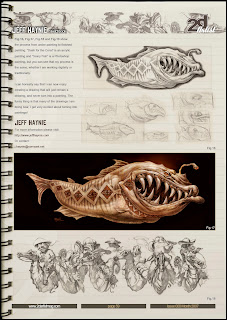
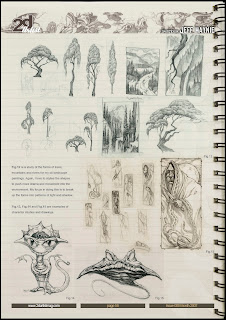
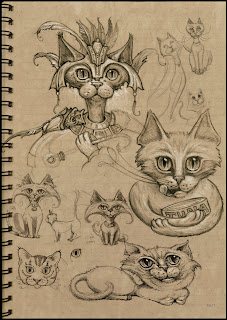
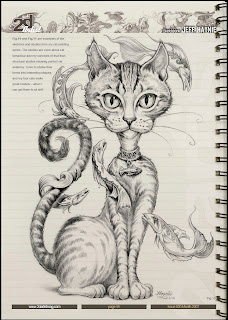
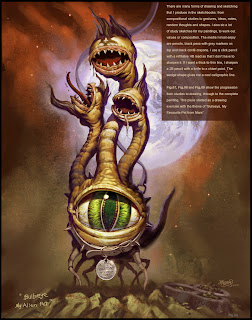

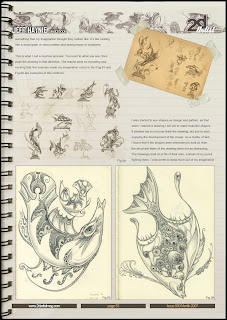


A few years ago I did an article in 2d artist magazine about the importance of carrying a sketchbook. Here is the complete article.
Art love and happy drawing,
Jeff
My sketchbook is my “portable playground” of ideas and images. It is a book I carry around with me everyday, wherever I go. This wasn’t always the case, however…
In the first 10 years of my professional career, I struggled with the desire to draw, much less carrying around a sketchbook to do that drawing in. I hated that part of the art process. It was only a means to get me to the painting stage, which was what I really thought I enjoyed the most.
At that time, when I would meet artists who carried around these amazing sketchbooks with pages and pages of gorgeous drawings, I just couldn’t relate to how an artist could flow with that much imagination and produce such quality drawings without using photo references. Where did the desire even come from or the drive to want to draw? How do you even think that way?
To develop that habit seemed, to me, an unreachable goal, achievable only by the super talented. Only others much more gifted than I could output that kind of beauty. And yet, I began to realise that there was a time in my life when I flowed like that… those early years in the elementary school playground when drawing was not a precursor to painting, but a fun task in its own right.
Today I love my sketchbook and the whole drawing process almost more than the painting process. My sketchbook has become the heart of who I am as an artist. It’s my place to play. What changed and how did I get there? The biggest change was in my thinking. I slowly developed the habit of sketching in the little bits of spare time I had in any given day (the bits of time I usually wasted).
Then an artist friend got me started by having me make random shapes on a page without thinking in advance about what I would draw. The next step was to take the shapes and turn them into something that my imagination thought they looked like. It’s like looking into a wood grain or cloud pattern and seeing faces or creatures.
This is what I call a reactive process. You react to what you see, then push the drawing in that direction. The results were so revealing and exciting that this exercise made my imagination come to life (Fig.01 and Fig.02 are examples of this method). I also started to see shapes as design and pattern, so that when I started a drawing I set out to make beautiful shapes. It allowed me to not over-think the drawing, but just to start enjoying the development of the image. As a matter of fact, I found that if the shapes were interesting to look at, then the structural flaws of the drawing were not as distracting. The drawings took on a life of their own, instead of my pencil fighting them. I now prefer to draw more out of my imagination as I study life. Even as I draw from real life, I begin to stylise the shapes to make them more interesting. Each artist has their own shape language, or style of drawing shapes, which makes their drawings unique.
I have many sketchbooks going on at any one time. My main sketchbook I carry around everyday in my backpack; I draw on the commuter train or at any opportunity I get during the day. One of my other sketchbooks is themed with just fantasy fish drawings (Fig.03, Fig.04, Fig.05, and Fig.06 are examples from my fish sketchbook).
There are many forms of drawing and sketching that I produce in the sketchbooks: from compositional studies to gestures, ideas, notes, random thoughts and shapes. I also do a lot of study sketches for my paintings, to work out values or composition. The media I most enjoy are pencils, black pens with grey markers on top and black conté crayons. I use a click pencil with a refillable HB lead so that I don’t have to sharpen it. If I want a thick-to-thin line, I sharpen a 2B pencil with a knife to a chisel point. The wedge shape gives me a cool calligraphic line.
Fig.07, Fig.08 and Fig.09 show the progression from studies to drawing, through to the complete painting. This piece started as a drawing exercise with the theme of “Bullseye, My Favourite Pet from Mars”.
Fig.10 and Fig.11 are examples of the sketches and studies from my cat painting series. The studies are more about cat behaviour and my concepts of that than structural studies showing perfect cat anatomy. I love to stylise their forms into interesting shapes, and my four cats make great models – when I can get them to sit still!
Fig.12 is a study of the forms of trees, mountains and rivers for my oil landscape paintings. Again, I love to stylise the shapes to push more drama and movement into the environment. My focus in doing this is to break up the forms into patterns of light and shadow.
Fig.13, Fig.14 and Fig.15 are examples of character studies and drawings.
Fig.16, Fig.17, Fig.18 and Fig.19 show the process from under-painting to finished painting. “Dash for the Coral” is an acrylic painting and “Scary Fish” is a Photoshop painting, but you can see that my process is the same, whether I am working digitally or traditionally.
I can honestly say that I can now enjoy creating a drawing that will just remain a drawing, and never turn into a painting. The funny thing is that many of the drawings I am doing now, I get very excited about turning into paintings!


Sketchbooks are the way to really see an artist's thought process. I generally enjoy them more than finished pieces.
ReplyDelete